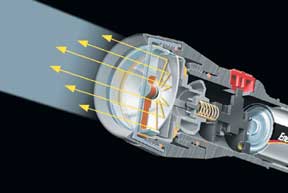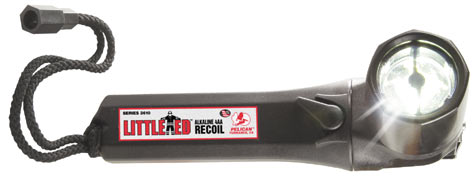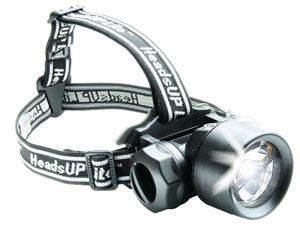Pelican Products Recoil Lighting
This is the first in a long series of gear reviews for boaters that I will be doing for Duckworks. Many of you have come to know of me on these pages in my second career as an emerging boat designer and promoter of off-the-wall ideas, such as the recent series regarding the Ultra-Microcruisers, Stasis7 and the Oceanic Pencil.
In the forthcoming gear reviews, I’m going to draw on more than thirty years of outdoor and boating experience to review products that fit in the envelope of stuff that could work for your next boating adventure. There’s a bio on my accumulated experience posted somewhere on the Duckworks site.
Some of the gear will be camping style stuff that you could use while on-shore and also in your boat, depending on the model and style of your boating adventures. Some will be meant specifically for boating and the unique problems and concerns associated with our sport.
I live in Salt Lake City, Utah and the outdoors is but a short drive in any direction. The stuff I will review will get to see mountain, desert and water environments on a regular basis. Some will be reviewed after a short, intense, interactive period and some after I’ve been “getting to know it” over many months.
I won’t pull any punches to gain favor with the manufacturers. I see my most important value with you guys as a person of wide, outdoor experience who can deliver the straight talk to you without any soft pedaling about the ability of a given piece of gear to perform as expected. If it doesn’t do what it’s supposed to do, I’ll tell you. If it does, I’ll give it a well-tested recommendation and put it on a posted list of stuff I would happily see on my boat, or in my truck when I go boating.
With the introduction resolved, here’s the first piece of gear for your consideration.
Pelican Products Recoil Lighting
Actually, this isn’t a single piece of gear. More like a cluster of products with a similar technological approach that will turn your head upside down as to how good a flashlight/headlamp can be.
We all know about light emitting diodes or LED’s as they’re more commonly referred to. They’ve been around for some time now in the more techy of lighting instruments and for good reason. They put out a nice light, they’re much less prone to breakage than conventional filament bulbs and fluorescents and they draw miniscule amounts of current which leads to very long battery life. When arrayed in clusters, they can create blinding light sources and when used in single and small arrays, they provide very nice “personal lighting” possibilities.
Carrying lots of batteries for a bright instrument is one of the hassles of conventionally bulbed flashlights and headgear. Not being able to throw a big beam out into the dark is the limitation of the typical LED product.
So, the question that naturally arises is, how do you get the brightness of a more conventional quartz or Zenon type bulb with the miniscule current draw of an LED?
The creative techno wizards at Pelican have managed to get the best of both worlds into a series of flashlights, as well as headgear, that can throw a beam like a freight train and yet, they barely eat any current at all.

There’s no tricky amplitude circuitry to give the hard using boater fits. The magic is in Pelican’s creative thinking and the way they use the LED bulb in the first place. Most LED style flashlights use the LED as one would typically use the conventional bulb. That is, they place the bulb, facing out, in the center of a reflector and call it good. The output is limited to the carry of that single LED with the reflector simply collecting the scattered light from the sides and back of the emitter to try to get it pointed out the front of the flashlight.
Pelican’s engineers, however, did something truly unique. They came up with a design that they call Recoil LED. They turned the bulb around and faced it backwards into a computer generated parabolic reflector so that every bit of the light from the emitter could be focused and formed into a useful beam as it emerged from the front of the flashlight head.
It’s the same principal that is used by microwave dish antennas to punch their signal, cleanly, over long distances and it works like no flashlight you’ve ever seen before. Not only is it bright, but it uses batteries in a truly stingy way that will probably give Duracell and Eveready a huge fit.
So, here are the new products from Pelican that use the Recoil technology.
All of these new units are seriously water resistant and a few of them are even dive rated to a depth of 500 feet. Now that’s waterproof! Since few, if any, of us are ever going to see a depth of 500 feet while in the water, that means these Recoil units will be more than adequate for anything we may encounter while engaged in normal boating activities.
Some of them run on AA batteries and others on C cells. One of them is even rechargeable and would be especially convenient for those who could use one where they have access to normal house current
Two of the Recoil units in the group are of special interest from my perspective. The Little Ed 3610 right angle hand held and the 2680 Recoil headlamp.
The Pelican Little Ed 3610

Picture this. You are out on the water after dark in your 16’ pride and joy and you have a real serious need to be seen as you cruise home to the launch ramp. You’re on your favorite fishing lake and there are several high powered fishing skiffs also headed for the ramp in the quickly fading light. Since you know where you are going and have a good handle on the speed and direction, your biggest concern turns to being seen by the fast approaching fishing rigs.
The simplest and quickest solution to high visibility in these conditions is to whip out your Pelican Little Ed and fasten it to the four point lash patch on the front of your PFD as you maintain your course and keep a hand on the tiller.
The 3610 is the little brother to Pelican’s, are you ready for this, Big Ed. The Big Ed carries C cell batteries and is not equipped with Recoil technology. The Little Ed is kind of quirky as flashlights go, but it’s surprising just how easily you can adapt to the right angle form. I was kind of skeptical of the unit when I first got it; thinking there but a few instances in which I would actually use something like this. At the top of the 3610 on the backside is a hefty stainless slide clip that is just perfectly designed to fit easily through the accessory patch on your PFD.
I’ve done hundreds of hours of sea kayaking expeditions in which I’ve been out paddling at night. In congested areas with lots of boating traffic, it’s been my habit to fix a flashing strobe on the back of my PFD and a 360-degree white light on the aft deck via a suction cup. Having used the Little Ed on the front of the PFD and benefiting from the nice strong beam as well as the ability to be seen quite easily, I’m going to include the 3610 in my expedition package for night boating. Retail price of about $39 and comes in black or safety yellow.
The 2680 Headsup Lite

This headlamp unit is one of the products in the Recoil line that is rated to 500 feet of submersion. It comes packaged with an elastic cloth T strap as well as a heavy duty rubber strap for more secure mounting to smooth surfaces such as diving, spelunking, white water and construction helmets.
The 2680 is an absolute lighthouse quality beacon in a compact package. It throws a beam of 33 lumens for 33 hours from four AA batteries contained in the waterproof cylinder right behind the LED head. I used this headlamp while on the recent Lake Powell Messabout and when I aimed the light off into the darkness around our little boating cove, I could see everything I the path of the beam with amazing clarity.
This is a beam-producing headlamp for very serious light output when you really need to see what is out there. I could really see this unit being perfect for lighting up the shore as you approach a camping location in the dark. The waterproof capability means it can be used in any and all weather conditions as well as used as a head mounted dive light.
Need to check the under side of your boat in the dark? Want to go lobster hunting in Baja after the sun goes down? The 2680 is the tool that is perfect for those jobs. The 2680 retails for right around $49 and is available in black only.
If I had any input with the Pelican folks with regards to product design on this particular headlamp, it would be to incorporate a second, switchable array of non-Recoil LED’s so that the headlamp could be used in a close-in condition without totally blinding the user. Really, this thing is certifiably bright and just way too much light for doing things that are close to you.
The second thing I’d like to see would be a remotely mounted auxiliary battery compartment for truly extended headlamp use. That switchability and long duration use capacity would make this the perfect outdoorsman’s headlamp.
One last thing about Pelican products… They are built to last and Pelican backs them up with the most comprehensive warranty in the business. They will cover any defects in workmanship in the units they build for life. They don’t cover shark bites, bear attacks and kids under five



